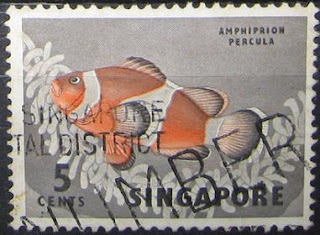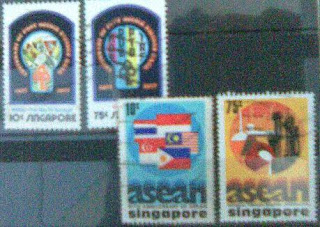Wikipedia has a very
good summary of the postal history for Straits settlement while SingPost website has some
good description of the postal department for Singapore. There are also a few other websites / books with snippets of information.
To save time for those want to have a quick look, I've summarised the sources from both Wiki (largely first part), SingPost (second half), and others. So in short, these descriptions are works of others, I merely summarised and shortened for ease of reading. A bit dry, but well it is important to know the history!
Singapore was originally part of the
Straits Settlement, including Penang and Malacca. So the letters and postcards were handled by the passing ships. In these early days, a single mail office collected and delivered the small volume of letters. It was located in the previous Parliament House (for Singapore case) and run by just three persons. According to Wiki, the earliest post-marks was from around 1806. Stamps was not invented until 1840. So it's just letters with post-marks.
The postal service for this region was formalised when the British passed the Indian Post Office Act. However, this region didn't warrant to have its own stamps. So stamps from India were still used from 1854. You can check if the stamps were from Straits Settlement by looking at the cancellation. Malacca used cancellation with 'B109', Penang 'B147' and Singapore 'B172'. As trade flourished, both postal and marine traffic grew. The Singapore "Post Office", as it was known, became a separate department from the Marine Office in October 1858.
When the Straits Settlement officially became part of the British empire around 1867, the first batch of stamps were produced. Interesting history right? That's why stamps of these years are very valuable because of the historical importance. Starting from 1 Sep 1867, nine types in the existing stocks of Indian stamps were overprinted with a crown and a new value in cents. Actual 'Straits Settlement' stamps, i.e. those with the name on it, were used only from December of 1867.

With a new British King (King Edward VII) in 1901/1902, there is a need for new stamp designs. So new stamps were used from 1903. From 1907, there were some overprints of the stamps from
Labuan with the words ' Straits Settlement', and larger denominations of $25 and $100 appeared from 1910 onwards. George V replaced his father on stamps beginning in 1912, reusing frames and only replacing vignettes.
Fullerton Building was the site of the Singapore's General Post Office (GPO) and was built between 1925 and 1928. An earlier GPO was demolished to make way for this building.
The last issue of the Settlements was for George VI beginning in 1937. From March 1942, the Japanese issued stamps for their occupation, made by overprinting existing stamps with Japanese inscriptions. In order to help the Japanese establish a common identity for this part of the world, the Japanese held a stamp design competition, and issued stamp designs (see picture below) in 1943.
When the Japanese left in 1945, the British military administration issued provisionals by overprinting Straits Settlements stamps with "BMA / MALAYA". These were available everywhere in Malaya, and used until regular postage stamp printing was organized.

From 1949, the Singapore Postal Department was aligned with the Postal Department of the Federation of Malaya. A colonial postal system was imposed which standardised rules, regulations, procedures and postage rates in both territories.
Singapore attained self-governance in November 1959 but the stamp issue featuring the Singapore flag (first time) was released only in 1960. Subsequently in September 1963, Singapore, Sarawak and
North Borneo (today's Sabah) joined Malaya and formed the Federation of Malaysia. Singapore 'split' from Malaysia in 1965 and become an independent country. There wasn't much stamp issues in between the September 1963-1965 period.
Following independence on 9 August 1965, Singapore took over its own postal functions in stages and became part of the
Universal Postal Union (UPU) on 8 January 1966. The Singapore Postal Services Department became a fully autonomous body on 1 January 1967. On 27 August 1968, Singapore set up the Stamp Advisory Committee (SAC) headed by Mr Phua Bah Lee. The SAC has the responsibility of advising the government on all matters concerning philately, as well as recommend stamp themes / designs. There are other philatelic organisations set up since then, including the Singapore Philatelic Society in 1966, and the much older Singapore Stamp Club in 1941.
On 4 December 1971, the Mail and Registration Branch from General Post Office moved to rented premises at a Port of Singapore Authority warehouse at Nelson Road. In 1982, the Postal Services Department merged with the then Telecommunication Authority of Singapore (TAS). In 1992, the TAS was split into three entities: the reconstituted TAS (now part of the Infocomms Development Authority), SingTel and SingPost.
In November 1983, the Mails and Parcels Centre moved from Nelson Road to bigger premises at Chai Chee Complex. At the Chai Chee Complex, Singapore introduced the optical character reader. With this technology, less manual processing is needed, i.e. save manpower. Seems like it was quite difficult to find candidates for the postman job back then. In September 1998, the mail-sorting operations at Chai Chee moved to the Singapore Post Centre located along Eunos Road 8, which was specially built for mail processing and houses advanced mail-sorting technology.
About 10 years have passed, and Singapore hosted the
World Stamp Championship in 2004. Actually, Singapore also hosted the World Stamp Exhibition in 1995 at the same location of Suntec City.






























